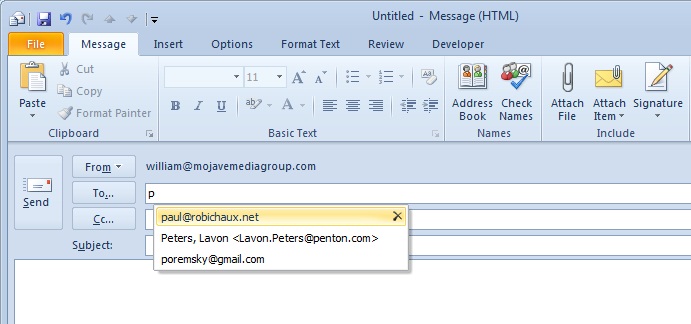Microsoft originally added the Outlook autocomplete feature, also called the [gs nickname] [gs cache], to increase efficiency in addressing email messages. The autocomplete list appears as you begin to type a recipient address in an Outlook form, most commonly a new email message. Figure 1 shows an example of content in the autocomplete list rendered while addressing a new [gs email] message.
Many users have become dependent on this cache for choosing email recipients when composing messages in Outlook. I've seen users address messages by typing the first letter of the recipient's name in the To field, then hitting Enter without even looking because they anticipate an address they frequently use will appear on top of the list.
Customers have asked for greater accessibility to the nickname cache, and even the ability to manipulate content therein. Third-party vendors have responded with applications that allow for more user control of the nickname cache.
In Outlook 2010, Microsoft moved the nickname cache from a file, <profile_name>.nk2, to a hidden message in the user's default message store (either .pst or Exchange [gs mailbox]). The developers also made the nickname cache a little more portable for users moving to Outlook 2010 by adding a command-line extension to import the content of an existing .nk2 file.
To import an existing nickname cache file, it requires that the .nk2 filename matches the name given to the Outlook profile into which the content is to be imported.
By default, Outlook assigns the profile name "Outlook" to the first profile created unless you manually change it. If you have only a single Outlook profile created for a user, it might just have that name. More likely, you've deployed Outlook to match profile names to user names.
To import an existing Outlook autocomplete cache file into an Outlook profile called Outlook, the .nk2 file will have to be renamed outlook.nk2. You must then save the file where it would reside in Outlook versions prior to Outlook 2010.
For Windows XP and Windows Server 2003, it's either:
\Documents and Settings\<username>\Application Data\Microsoft\Outlook
or
%appdata%\Microsoft\Outlook
In Windows 7, Windows Vista, and Windows Server 2008, the location would be:
\users\<username>\AppData\Roaming\Microsoft\Outlook\
Outlook 2010 must be fully closed; that is, the outlook.exe process must not be visible in the Task Manager Process tab.
Then, you initiate Outlook 2010 via the [gs command line] with the following switch:
C:\Progam files\Microsoft Office\Office14>outook.exe /importNK2
When this command is executed, you're actually starting Outlook.
The import of the .nk2 file takes place as Outlook starts. This switch has no additional options-you can't select an alternate path to an .nk2 file with a filename that doesn't match the profile, for example. Figure 2 shows the error you'll see if the switch is misspelled or parameters are added.
This import doesn't replace your existing cached addresses, but rather merges the content of the .nk2 file into the hidden message holding the Outlook 2010 nickname cache. The imported addresses will appear at the top of suggested recipients when the [gs user] starts typing in recipient address fields.
To prevent the file from being re-imported, Outlook changes the file name by adding a .old extension to the file. The file is otherwise unchanged and can be re-imported if necessary after removing the .old extension. Microsoft doesn't include any messages confirming a successful import to the user.
The upgrade process from Outlook 2007 to Outlook 2010 will migrate users' nickname caches automatically. It might be valuable to migrate nickname caches for users who are migrating from previous Outlook versions as well. Companies that have a set of addresses they anticipate their employees using on a regular basis could include such a cache in new Outlook 2010 deployments.
They could use an .nk2 file saved from Outlook 2007 (or amended with a third-party application) and use the /importNK2 command-line switch to include that nickname [gs cache] template as part of their Outlook 2010 deployment [gs procedure].
SOURCE | LINK | LANGUAGE | ENGLISH |




How can I import Outlook autocomplete (NK2) files into Outlook 2010 http://heelpbook.altervista.org/2012/how-can-i-import-outlook-autocomplete-nk2-files-into-outlook-2010/ via @HeelpBook